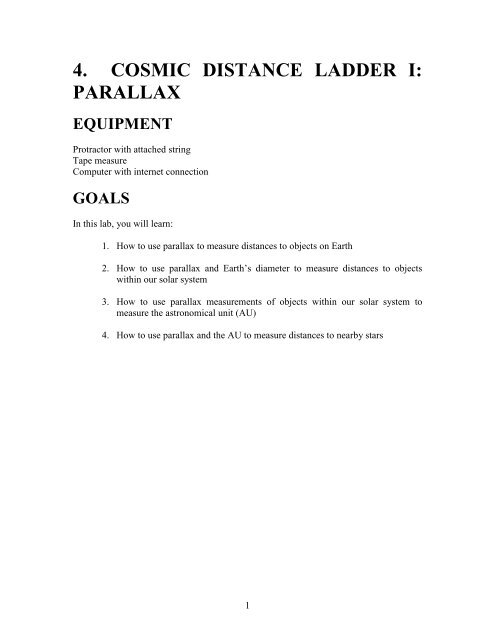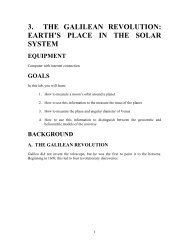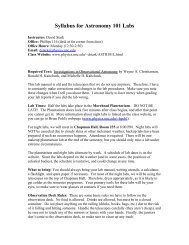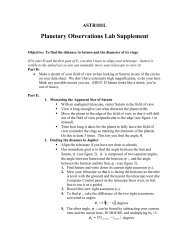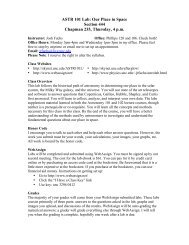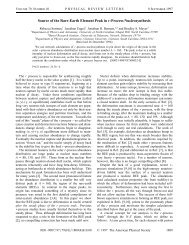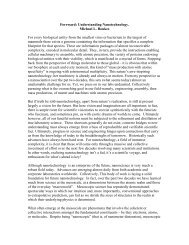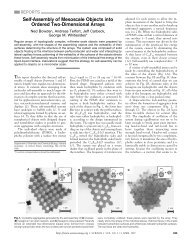4. cosmic distance ladder i: parallax - Department of Physics and ...
4. cosmic distance ladder i: parallax - Department of Physics and ...
4. cosmic distance ladder i: parallax - Department of Physics and ...
Create successful ePaper yourself
Turn your PDF publications into a flip-book with our unique Google optimized e-Paper software.
<strong>4.</strong> COSMIC DISTANCE LADDER I:<br />
PARALLAX<br />
EQUIPMENT<br />
Protractor with attached string<br />
Tape measure<br />
Computer with internet connection<br />
GOALS<br />
In this lab, you will learn:<br />
1. How to use <strong>parallax</strong> to measure <strong>distance</strong>s to objects on Earth<br />
2. How to use <strong>parallax</strong> <strong>and</strong> Earth’s diameter to measure <strong>distance</strong>s to objects<br />
within our solar system<br />
3. How to use <strong>parallax</strong> measurements <strong>of</strong> objects within our solar system to<br />
measure the astronomical unit (AU)<br />
<strong>4.</strong> How to use <strong>parallax</strong> <strong>and</strong> the AU to measure <strong>distance</strong>s to nearby stars<br />
1
1. BACKGROUND<br />
A. THE COSMIC DISTANCE LADDER<br />
Distance is one <strong>of</strong> the most difficult things to measure in astronomy. You cannot see<br />
<strong>distance</strong>: You never know if you are looking at a low-luminosity star nearby (A) or a<br />
high-luminosity star far away (B):<br />
In both cases, the star can appear to be equally bright.<br />
2
To deal with this, astronomers have developed a hierarchy <strong>of</strong> techniques for measuring<br />
greater <strong>and</strong> greater <strong>distance</strong>s:<br />
In Lab 2, you measured Earth’s diameter in kilometers. This is the base <strong>of</strong> the <strong>cosmic</strong><br />
<strong>distance</strong> <strong>ladder</strong>.<br />
In this lab, you will use Earth’s diameter in kilometers <strong>and</strong> a technique called <strong>parallax</strong> to<br />
measure <strong>distance</strong>s to two solar-system objects: an asteroid <strong>and</strong> the planet Venus.<br />
You will then use your measurement <strong>of</strong> the <strong>distance</strong> to Venus to determine how many<br />
kilometers are in one astronomical unit (AU). One AU is the average <strong>distance</strong> between<br />
Earth <strong>and</strong> the sun.<br />
Finally, you will use your measurement <strong>of</strong> the AU in kilometers <strong>and</strong> <strong>parallax</strong> to measure<br />
the <strong>distance</strong> to the closest star system to the sun: Alpha Centauri.<br />
With current technology, <strong>parallax</strong> can only be used to measure <strong>distance</strong>s out to about 500<br />
parsecs, which is about 1.5 × 10 16 kilometers. This might seem like a great <strong>distance</strong>, but<br />
it is only about 7% <strong>of</strong> the way to the center <strong>of</strong> our Milky Way galaxy. In Labs 5 <strong>and</strong> 7,<br />
you will learn techniques that can be used to measure <strong>distance</strong>s across the entire Milky<br />
Way galaxy <strong>and</strong> to other galaxies, both nearby <strong>and</strong> far away.<br />
3
B. PARALLAX<br />
Hold a pencil vertically in front <strong>of</strong> <strong>and</strong> close to your nose. Focus on distant objects or a<br />
background wall. Close one eye <strong>and</strong> then open it while closing the other. Notice how<br />
much your pencil appears to shift with respect to the distant objects. This is called<br />
<strong>parallax</strong>: the apparent shift <strong>of</strong> a foreground object with respect to background<br />
objects due only to a change in the observer’s position.<br />
Now, hold your pencil at arms length <strong>and</strong> repeat this exercise. Is the angular shift smaller<br />
or larger?<br />
The closer the foreground object, the larger the angular shift. The farther away the<br />
foreground object, the smaller the angular shift:<br />
4
The <strong>distance</strong> between the two observing positions is called the baseline. In the above<br />
exercise, the baseline is the <strong>distance</strong> between your eyes.<br />
Astronomically, two baselines are commonly used:<br />
1. Earth-Baseline Parallax: The two observing positions are different positions on<br />
Earth, in which case the baseline is a fraction <strong>of</strong> Earth’s diameter (which you measured in<br />
Lab 2):<br />
5
2. Stellar Parallax: The two observing positions are on opposite sides <strong>of</strong> Earth’s orbit<br />
around the sun, in which case the baseline is two AU (which you will measure in section<br />
D <strong>of</strong> the procedure <strong>of</strong> this lab):<br />
6
In either case, the relationship between the baseline between the two observing positions,<br />
the angular shift <strong>of</strong> the foreground object due to <strong>parallax</strong>, <strong>and</strong> the <strong>distance</strong> to the<br />
foreground object is the same:<br />
1. Earth-Baseline Parallax:<br />
2. Stellar Parallax:<br />
7
The baseline as a fraction <strong>of</strong> the circumference <strong>of</strong> the big circle is the same as the angular<br />
shift as a fraction <strong>of</strong> 360°:<br />
baseline / circumference = θ / 360°<br />
Since circumference = 2π times radius <strong>and</strong> the radius <strong>of</strong> the big circle is the <strong>distance</strong> to<br />
the foreground object:<br />
baseline / (2π × <strong>distance</strong>) = θ / 360°<br />
Solving for the <strong>distance</strong> to the foreground object yields:<br />
<strong>distance</strong> = (baseline / 2π) × (360° / θ)<br />
Note: Remember to convert θ to degrees before using this equation!<br />
Hence, by (1) knowing the baseline between two observing points, <strong>and</strong> (2) measuring the<br />
angular shift <strong>of</strong> a foreground object due to <strong>parallax</strong>, you can (3) measure the <strong>distance</strong> to<br />
the foreground object.<br />
Under ideal circumstances, Earth-baseline <strong>parallax</strong> can be used to measure <strong>distance</strong>s to<br />
objects out to about 500 AU, beyond which the angular shift is too small to be measured<br />
accurately given current technology.<br />
However, larger baselines result in larger, <strong>and</strong> consequently easier to measure, angular<br />
shifts: Stellar <strong>parallax</strong> can be used to measure <strong>distance</strong>s to objects out to about 500 pc,<br />
which is about 10 8 AU.<br />
To measure <strong>distance</strong>s to objects beyond 500 pc, astronomers employ st<strong>and</strong>ard-c<strong>and</strong>le<br />
techniques, which is the subject <strong>of</strong> Lab 5.<br />
8
1. PROCEDURE<br />
A. DISTANCES TO OBJECTS ON EARTH<br />
We will begin by using <strong>parallax</strong> to measure <strong>distance</strong>s to two objects here on Earth.<br />
On-campus students will st<strong>and</strong> behind the south wall <strong>of</strong> the Chapman Observing Deck<br />
<strong>and</strong> measure <strong>distance</strong>s to two objects in front <strong>of</strong> them: (1) a smokestack on the ro<strong>of</strong> <strong>of</strong><br />
Morehead Laboratory (not Morehead Planetarium or Morehead Observatory), <strong>and</strong> (2) the<br />
campus water tower:<br />
Note: Online students will need to find a wall, or fence, or similar structure behind<br />
which they can st<strong>and</strong> <strong>and</strong> over which they can identify two objects to measure <strong>distance</strong>s<br />
to.<br />
9
First, st<strong>and</strong> on the far left side <strong>of</strong> the wall. Place your protractor flush against the back <strong>of</strong><br />
the wall <strong>and</strong> squat down such that your eyes are right behind where the string attaches to<br />
the protractor. Move the string such that it points to the smokestack:<br />
Without moving the string, st<strong>and</strong> up <strong>and</strong> read the angle <strong>of</strong>f <strong>of</strong> the protractor to the nearest<br />
0.1 degrees:<br />
first angle: ____________________<br />
Mark the position <strong>of</strong> your protractor on the wall (e.g., with a pebble) <strong>and</strong> move to the far<br />
right side <strong>of</strong> the wall. Repeat your measurement:<br />
second angle: ____________________<br />
The positive value <strong>of</strong> the difference between these two angles is the angular shift due to<br />
<strong>parallax</strong>:<br />
angular shift = | first angle – second angle |<br />
angular shift = ____________________<br />
10
Next, use the tape measure to measure the baseline between your two observing positions<br />
in feet:<br />
baseline = ____________________<br />
Note: The tape measure will probably not be long enough, in which case measure one<br />
part at a time <strong>and</strong> add the measurements together.<br />
Calculate the <strong>distance</strong> to the smokestack using <strong>parallax</strong>:<br />
<strong>distance</strong> = (baseline / 2π) × (360° / θ)<br />
<strong>distance</strong> = ____________________<br />
The true <strong>distance</strong> to the smokestack is 360 feet. Calculate your percent error:<br />
percent error = ____________________<br />
Note: To calculate percent errors, online students will need to measure the true<br />
<strong>distance</strong> to each <strong>of</strong> their objects with the tape measure. Consequently, select objects<br />
that are not unreasonably far away (but certainly farther away than the length <strong>of</strong> your<br />
baseline).<br />
Repeat this exercise for the water tower:<br />
first angle: ____________________<br />
second angle: ____________________<br />
angular shift = ____________________<br />
baseline = ____________________<br />
<strong>distance</strong> = ____________________<br />
The true <strong>distance</strong> to the water tower is 2800 feet. Calculate your percent error:<br />
percent error = ____________________<br />
In your lab report, discuss sources <strong>of</strong> error. Which <strong>of</strong> your measurements was less<br />
accurate? Why? At what point is <strong>parallax</strong> not an accurate technique for measuring<br />
<strong>distance</strong>? What are two ways that you could more accurately measure the <strong>distance</strong> to an<br />
object using <strong>parallax</strong>?<br />
11
B. OBSERVE AN ASTEROID WITH SKYNET<br />
First, we are going to try to observe an asteroid with Skynet telescopes in different<br />
hemispheres, to measure its <strong>distance</strong> with <strong>parallax</strong>.<br />
Since asteroids (<strong>and</strong> planets) move across the sky quickly, the two telescopes will need to<br />
image the asteroid simultaneously. That way, any difference in the asteroid’s position<br />
between the images will be due to <strong>parallax</strong>, instead <strong>of</strong> due to the asteroid moving between<br />
when the two images were taken.<br />
This is a very challenging observation to make. First <strong>of</strong> all, different telescopes will take<br />
different amounts <strong>of</strong> time to slew into position. Consequently, we will shoot a rapid-fire<br />
sequence <strong>of</strong> images from both telescopes. Both telescopes might not start their sequences<br />
at the same time, but as long a one image in the first telescope’s sequence overlaps in<br />
time with one image in the second telescope’s sequence, we will be good to go.<br />
This observation is also challenging to make because although the PROMPT telescopes<br />
belong to UNC-Chapel Hill, most <strong>of</strong> Skynet’s northern hemisphere telescopes do not.<br />
Your priority level is not high enough to override them, but for this week only we will<br />
give your instructor a priority level that is high enough to do this. Consequently, we will<br />
request only one set <strong>of</strong> observations per section.<br />
12
Your instructor will select an asteroid that is observable to both PROMPT <strong>and</strong> the Skynet<br />
telescopes in North America for at least ten minutes each night, this time <strong>of</strong> year. S/he<br />
will then request (1) 15 40-second, open-filter exposures on all available PROMPT<br />
telescopes, <strong>and</strong> (2) 15 40-second, open-filter exposures on all available Skynet telescopes<br />
in North America. Finally, for both observations, s/he will set “Don’t start before<br />
(UTC):” to a time that the asteroid is observable to all <strong>of</strong> these telescopes:<br />
If both observations do not go through on the first night (e.g., if a gamma-ray burst goes<br />
<strong>of</strong>f, or if all <strong>of</strong> the telescopes in one hemisphere or the other are clouded out or <strong>of</strong>fline)<br />
you instructor will re-request the observations each night until both go through.<br />
You will be able to access these images once they are completed from your instructor’s<br />
folder under “Sample Images”, “Astro 101 Lab”, “Lab 4 – Parallax”.<br />
13
C. DISTANCE TO AN ASTEROID<br />
First, use Afterglow to identify which object is the asteroid:<br />
1. Identify which <strong>of</strong> the two telescopes produced better images.<br />
2. Select <strong>and</strong> align all <strong>of</strong> the images from this telescope. For “Alignment Method”,<br />
select “One Star Manual”. For “Cropping Method”, select “Overlap Only”. Select<br />
“Centroid Sources” <strong>and</strong> “Stellar Method (PSF)”. In your first image, identify a bright,<br />
but not saturated, star that is not on the edge <strong>of</strong> the image. Align to this star in each <strong>of</strong><br />
the images.<br />
3. Turn your selected <strong>and</strong> aligned images into a movie. The asteroid will be the moving<br />
object, unless you accidentally aligned to the asteroid, in which case everything else in<br />
the image will be moving. Download your movie <strong>and</strong> include it in your lab report.<br />
14
In the following tutorial, you will learn how to select <strong>and</strong> align images that were taken by<br />
different telescopes:<br />
http://skynet.unc.edu/ASTR101L/videos/align2/<br />
In the following tutorial, you will learn (1) how to overlay two images that have already<br />
been aligned <strong>and</strong> (2) how to measure the angular shift <strong>of</strong> a relatively nearby object in the<br />
images due to <strong>parallax</strong>:<br />
http://skynet.unc.edu/ASTR101L/videos/overlay/<br />
Next, use Afterglow (1) to select, align, <strong>and</strong> overlay two images <strong>of</strong> the asteroid that were<br />
taken nearly simultaneously by Skynet telescopes in different hemispheres <strong>and</strong> (2) to<br />
measure the angular shift <strong>of</strong> the asteroid due to <strong>parallax</strong>:<br />
1. Your instructor will help you to identify two images that were taken nearly<br />
simultaneously.<br />
2. Select <strong>and</strong> align these images. For “Alignment Method”, select “Two Star Manual”.<br />
For “Cropping Method”, select “Overlap Only”. Select “Centroid Sources” <strong>and</strong> “Stellar<br />
Method (PSF)”. For alignment, use two stars (1) that are bright, but not saturated, (2)<br />
that are not close to one another in the images, <strong>and</strong> (3) that are in both images. Do not<br />
use the asteroid!<br />
3. Overlay your two aligned images <strong>and</strong> measure the angular shift <strong>of</strong> the asteroid due to<br />
<strong>parallax</strong>, to the nearest 0.1 arcseconds:<br />
angular shift = ____________________<br />
15
The baseline between your two observing positions as a fraction <strong>of</strong> Earth’s diameter is:<br />
Baseline Between CTIO And<br />
Fraction <strong>of</strong> Earth’s Diameter<br />
Dark Sky Observatory, NC 0.554<br />
Hampden-Sydney College Observatory, VA<br />
Hume Observatory, CA<br />
Morehead Observatory, NC 0.554<br />
Pisgah Astronomical Research Institute, NC<br />
Coyote Rim Ranch, CO<br />
You measured Earth’s diameter in Lab 2:<br />
measured diameter from Lab 2: ____________________<br />
true diameter: ____________________<br />
Calculate the baseline between the two observing positions using Earth’s true diameter:<br />
baseline = fraction <strong>of</strong> diameter × true diameter<br />
baseline = ____________________<br />
Calculate the <strong>distance</strong> to the asteroid using <strong>parallax</strong>:<br />
<strong>distance</strong> = (baseline / 2π) × (360° / θ)<br />
Note: Remember to convert θ to degrees before using this equation!<br />
<strong>distance</strong> = ____________________<br />
Main-belt asteroids are typically between 1.6 × 10 8 km <strong>and</strong> 6.4 × 10 8 km from Earth.<br />
Given this, is your measurement reasonable? In your lab report, discuss sources <strong>of</strong> error.<br />
16
D. DISTANCE TO VENUS AND THE SIZE OF THE AU<br />
To measure <strong>distance</strong>s to nearby stars with stellar <strong>parallax</strong>, where the baseline is 2 AU, we<br />
must first measure how many kilometers are in one AU. Historically, this was done by<br />
measuring the <strong>distance</strong> to Venus in kilometers using Earth-baseline <strong>parallax</strong> when Venus<br />
was a known number <strong>of</strong> AU away.<br />
For example, Venus is observed to orbit the sun every P = 0.62 years.<br />
Kepler’s Third Law states that for objects orbiting the sun:<br />
(P / 1 year) 2 = (a / 1 AU) 3<br />
where a is the semi-major axis <strong>of</strong> Venus’s orbit. Solving for a yields:<br />
a = (P / 1 year) 2/3 AU<br />
Hence,<br />
a = (0.62) 2/3 = 0.73 AU<br />
Earth’s semi-major axis is 1 AU, by definition. Consequently, when Venus is at closest<br />
approach to Earth, it is 1 AU – 0.73 AU = 0.27 AU away:<br />
17
However, we could not wait until Venus was at closest approach to Earth to image it.<br />
Besides, it is very challenging to image Venus at closest approach to Earth because it is<br />
very close to the sun in the sky <strong>and</strong> its phase is very close to new.<br />
Instead, we imaged Venus when its phase was a waxing gibbous:<br />
18
Venus can only be a waxing gibbous <strong>of</strong> this phase when it is in a particular location in its<br />
orbit around the sun relative to Earth:<br />
This particular location is 1.34 AU from Earth:<br />
19
We took simultaneous images <strong>of</strong> Venus from CTIO in Chile <strong>and</strong> from Morehead<br />
Observatory in North Carolina. Since Venus is so bright, we had to use a special filter<br />
that blocks most <strong>of</strong> the light in the center <strong>of</strong> the image but very little light elsewhere in<br />
the image. This way, we could image for long enough to see stars in the images, which<br />
are needed to overlay the two images, without saturating Venus, which is needed to<br />
measure its angular shift due to <strong>parallax</strong>:<br />
These filters are no longer on the telescopes, so we will use the images that we took<br />
previously. You can access them under “Sample Images”, “Astro 101 lab”, “Lab 4 –<br />
Parallax”, “Venus”.<br />
20
Use Afterglow to overlay these images <strong>and</strong> measure the angular shift <strong>of</strong> Venus between<br />
the images due to <strong>parallax</strong>, to the nearest 0.1 arcseconds:<br />
angular shift = ____________________<br />
Calculate the baseline between the two observing positions using Earth’s true diameter:<br />
baseline = fraction <strong>of</strong> diameter × true diameter<br />
baseline = ____________________<br />
Calculate the <strong>distance</strong> to Venus using <strong>parallax</strong>:<br />
<strong>distance</strong> = (baseline / 2π) × (360° / θ)<br />
Note: Remember to convert θ to degrees before using this equation!<br />
<strong>distance</strong> = ____________________<br />
Now, since:<br />
1.34 AU = <strong>distance</strong><br />
1 AU = <strong>distance</strong> / 1.34<br />
1 AU = ____________<br />
The true value is 1.5 × 10 8 km. Calculate your percent error:<br />
percent error = ____________________<br />
In your lab report, discuss sources <strong>of</strong> error.<br />
21
E. DISTANCE TO ALPHA CENTAURI<br />
Finally, we are going to measure the <strong>distance</strong> to Alpha Centauri using stellar <strong>parallax</strong>.<br />
Actually, Alpha Centauri consists <strong>of</strong> two stars – A <strong>and</strong> B – in close proximity to each<br />
other.<br />
Like Venus, Alpha Centauri is sufficiently bright that we had to use one <strong>of</strong> our special<br />
filters to detect other stars without saturating Alpha Centauri:<br />
Again, since these filters are no longer on the telescopes we will use images that we took<br />
previously. You can access them under “Sample Images”, “Astro 101 lab”, “Lab 4 –<br />
Parallax”, “Alpha Centauri”.<br />
22
Use Afterglow to align these images <strong>and</strong> measure the angular shift <strong>of</strong> Alpha Centauri<br />
between the images due to <strong>parallax</strong>, to the nearest 0.1 arcseconds:<br />
angular shift = ____________________<br />
These images were taken six months apart, first when Earth was as far to one side <strong>of</strong><br />
Alpha Centauri as it can get <strong>and</strong> again when Earth was as far to the other side <strong>of</strong> Alpha<br />
Centauri as it can get. Consequently, the baseline between the two observing positions is<br />
how many AU across?<br />
baseline in AU = ____________________<br />
First, convert this to kilometers using your measurement <strong>of</strong> how many kilometers are in<br />
an AU:<br />
measured baseline in kilometers = ____________________<br />
Now convert it to kilometers using the true value:<br />
true baseline in kilometers = ____________________<br />
Calculate the <strong>distance</strong> to Alpha Centauri using <strong>parallax</strong> <strong>and</strong> the true baseline in<br />
kilometers:<br />
<strong>distance</strong> = (baseline / 2π) × (360° / θ)<br />
Note: Remember to convert θ to degrees before using this equation!<br />
<strong>distance</strong> = ____________________<br />
Google the true value:<br />
true <strong>distance</strong> = ____________________<br />
Calculate your percent error:<br />
percent error = ____________________<br />
In your lab report, discuss sources <strong>of</strong> error.<br />
23


